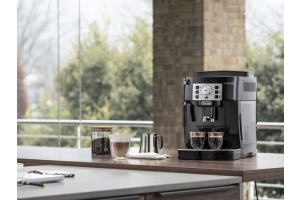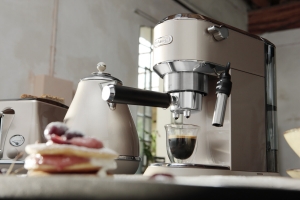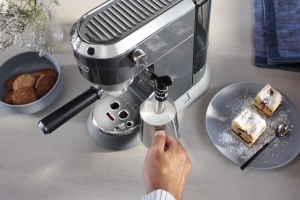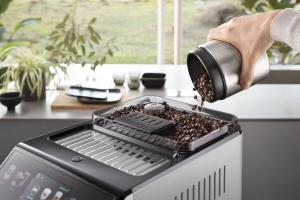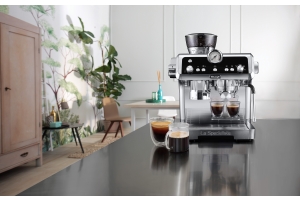Drip Coffee Makers vs Espresso Machines: Which Should You Go For?

Before deciding on a drip coffee maker or an espresso machine, you first need to understand the difference between the two types of coffee these appliances can brew. Even though all coffee comes from coffee beans, each machine has a different process and, thus, creates an altogether different coffee experience.
But which machine should you invest in for the best cuppa? Read on to find out!
The Low-down on Espresso Coffee Machines

Espresso is an Italian drink that coffee lovers across the world have now adopted. Brewed using espresso makers that force pressurised water near boiling point through a puck of finely ground coffee and filter, the end product is a ‘shot’ of rich and creamy flavoured coffee. Espresso coffee can be consumed as it is or used as the base for other types of coffee, such as macchiato, long black, latte, and more.
Contrary to popular belief, espresso machines are not the same as other types of coffee makers. The main difference lies in the pressure with which water is forced through the coffee grounds. For instance, traditional drip coffee makers allow gravity to slowly put hot water through the coffee grounds, whereas espresso machines force water through at approximately nine bars of pressure to produce a more concentrated and flavourful cuppa.
The easiest way to make an espresso coffee is with an espresso machine. Espresso machines come in both semi-automatic and fully automatic varieties. Both of them require basic maintenance and cleaning procedures to ensure not just the longevity of your espresso machine but the consistent quality of your coffee. Here are some features that set these two types of espresso machines apart.
Fully automatic espresso machines
As its name suggests, do everything from grinding your coffee beans to tamping the grounds, brewing the coffee, and even frothing the milk. Having these processes automated takes a lot of the guesswork out of making a great cup of espresso. However, the downside is that it tends to be more expensive than its semi-automatic counterparts.
Semi-automatic espresso coffee machines
This type of coffee machine requires the user to do some of the work, like grinding their beans and tamping the grounds. These espresso machines do less of the work for you so that you can learn more about the craft of espresso making. You still have to follow the same steps as you would using a fully automatic espresso coffee machine, but you have control over the length of the shot.
If you would like to brew espresso coffee, then the benefit of a semi-automatic espresso machine gives you complete control over the extraction timing from start to finish, as well as your espresso’s flavour. But, if you want an authentic espresso brewing experience without the hassle or having to worry about screwing up the flavour, then a fully automatic espresso machine will be ideal for you.
Ease of use
When it comes to using espresso coffee makers, things can be a little more complicated. Even though De’Longhi’s pump espresso coffee makers, like the La Specialista Prestigio and Arte, are renowned for their sophistication, style, and amazing coffee results, there are still some steps in which you require a certain level of skill and knowledge. One such example is tamping.
While fully automatic coffee machines are often said to be easier to operate, they also require more advanced knowledge of knowing how to make an espresso. However, those familiar with the coffee brewing process will find fully automatic espresso machines easy to use.
The Basics of Drip Coffee Machines

In general, drip coffee makers are a rather popular choice for many at-home coffee brewers. Not only are they easy to use, but there is also a wide variety to choose from. Drip coffee makers brew coffee by heating water before dripping it over coffee grounds. The hot water is typically heated by an element in the coffee maker, whereas the dripping action is accomplished by gravity. Certain models also come with a pre-infusion feature, allowing users to wet the coffee grounds before the brewing process begins. This, in turn, helps to extract more flavours from your coffee beans.
While brew times for drip coffee makers vary depending on the model, most can complete a full pot of coffee in five minutes or less. Drip coffee makers also provide a quick and simple way of getting your coffee in the morning. Simply add your coffee ground and water, push a button, and you can continue about your day as your beverage brews. Some drip coffee machines are also programmable, so you can set them to have your coffee ready by the time you start your day!
One major drawback of using drip coffee machines is that they use coffee filters, which soak up the natural oils in coffee. Some may prefer this for the clarity of flavour; however, if you like your coffee with a rich and robust flavour, you may want the natural oils.
Ease of use
Typically, drip coffee machines are easy to use:
- Start by heating up water in a kettle; approximately 200mL of water is needed for each cup of coffee you brew.
- While waiting for the water to heat up, grind your coffee beans to a medium-fine grind. It’s alright if you are using pre-ground coffee too; just be sure it is not too fine to prevent it from clogging your filter paper.
- Once the water is heated and your coffee grounds are ready, place a filter paper into your drip coffee maker’s filter holder and wet it with the hot water. This is essential in removing any papery taste of the filter paper.
- Add your coffee grounds to the filter paper and give it a gentle shark to level off the grounds.
- With a steady hand, slowly pour the hot water over your coffee grounds, evenly distributing it. Avoid pouring all of the water in at once, as it can result in an uneven extraction.
- Let the coffee brew for approximately three to five minutes or until the water has filtered through all of the grounds and into the pot.
- Once your coffee is brewed, remove the filter holder and discard the used grounds.
- Serve your coffee and enjoy!
Take drip coffee brewing a step further with De’Longhi’s range of automatic drip coffee machines. For example, the Active Line 5-Cup Drip Coffee Machine comes with an aroma function and clear level indicator for ultimate precision in brewing coffee. It also comes with a removable coffee filter and glass pot for ease of cleaning.
De’Longhi also offers the Clessidra Pour Over Coffee Maker, designed to replicate the pour-over coffee method of brewing, all with just a touch of a button. Furthermore, it is also equipped with a high-quality filter coffee brewing function, a 10-cup carafe, an anti-drip system, auto-shutoff capabilities, as well as a descaling alarm. These ensure you have everything you need to achieve the perfect cup of drip or pour-over coffee in the comforts of home.
All things considered, drip coffee machines make for better beginner-friendly appliances when compared to semi-automatic and fully automatic espresso coffee machines.
Coffee Specialties for Drip Coffee Makers and Espresso Machines

Even though both drip coffee makers and espresso machines have the capability to brew a variety of coffee, each machine is still subjected to different strengths and weaknesses. For instance, the drip coffee apparatus takes a longer brewing time and is better at extracting lighter roast flavours of coffee beans. However, espresso machines are better for brewing darker roasts of coffee since they have a shorter brewing time.
Flavour Profile Comparison of Drip Coffee and Espresso

Besides features and convenience, another factor you can consider when choosing between a drip coffee maker and an espresso machine is the flavour profile.
As mentioned earlier, drip coffee makers and espresso machines have distinct brewing methods. And, with different brewing methods come coffees that embody distinct tastes, textures, and flavour profiles.
Drip coffee is typically less bitter when compared to espressos since the water is allowed to drip slowly through the grounds, extracting flavours before dripping into the pot. While this process is more tedious since no forceful pressure is needed to push water through the grounds, you’ll get coffee with a balanced flavour profile.
On the other hand, Espresso boasts a more concentrated and intense flavour profile due to high-pressure water being forced through the grounds. As such, delivering a more robust flavour that many coffee drinkers know and love.
When it comes to texture, drip coffee has a thinner consistency than espressos because more water is used in the brewing process. Since lesser water is used to brew espressos, this type of coffee has a thicker consistency.
Hence, if you like a strong and bold coffee with a robust flavour profile, then espresso machines are ideal for you. However, a drip coffee machine would be a better choice if you prefer something that is more balanced and less intense. To put it simply, it boils down to what and how you like your coffee.
Ease of Cleaning Between Drip Coffee Makers and Espresso Machines
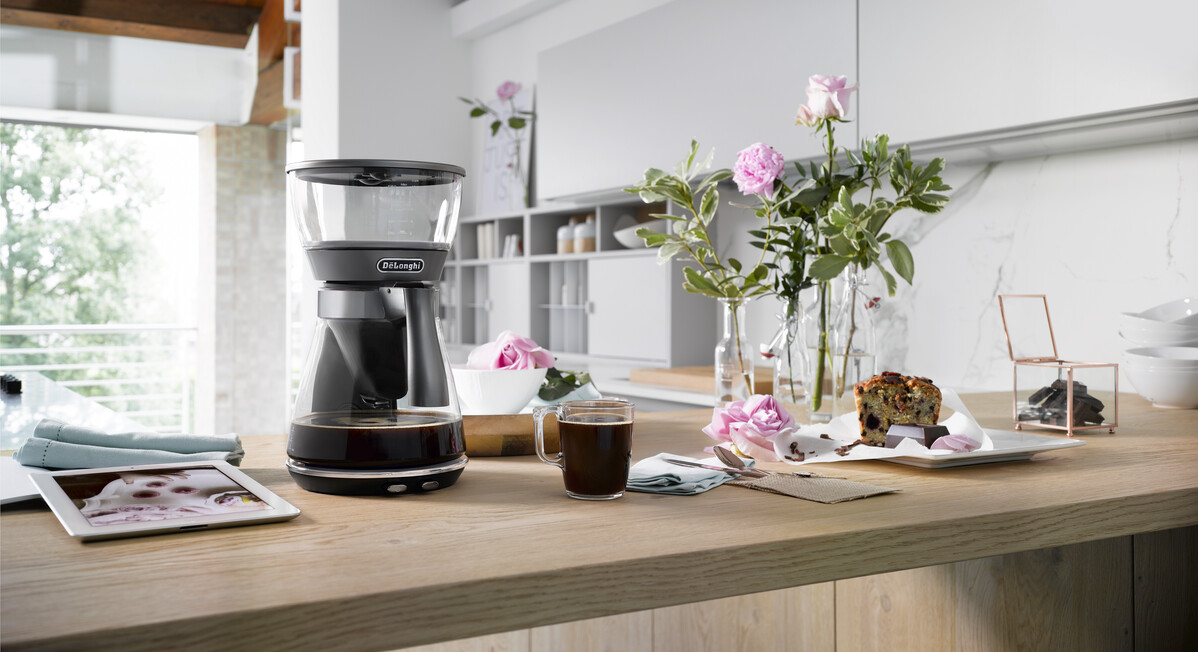
One other important consideration when deciding between a drip coffee maker and an espresso machine is the ease of cleaning and maintenance of each type of machine.
Drip coffee makers are generally much easier to clean as compared to espresso machines – there are fewer moving parts and thus less potential for messes. Espresso machines, however, have more complex internals (like the boiler and pump), which can be difficult to clean and maintain.
So, if you want a coffee maker that is easy to maintain and clean, then a drip coffee machine is your best bet. However, if a robust shot is what you need and you don’t mind taking the time for cleaning and maintenance, then an espresso machine is definitely worth it!
Entailed Costs of Each Coffee Maker

When comparing between the two, drip coffee machines are more affordable, with the De’Longhi Active Line 5-Cup Drip Coffee Machine retailing at only RM229 while the Clessidra Pour Over Coffee Maker is priced at RM599 for its dual functionality – filter coffee maker machine and pour-over coffee maker.
Semi-automatic espresso machines, however, are slightly pricier since they come with added functionality, sophistication, and versatility. For instance, the La Specialista Arte retails for RM3,699, while the La Specialista Prestigio is priced higher at RM4,899. However, if these are outside of your budget, fret not, as we have more affordable options. You can consider the Stilosa Manual Pump Coffee Machine, which is priced more affordably at RM699 or the Dedica line of pump espresso machines that start from RM1,499.
If you would like to add a fully automatic espresso machine to your home, then you have to be prepared for the cost, as some models, like the De’Longhi PrimaDonna Elite Experience retails at RM11,999. For more wallet-friendly options that can give you the same, consistent quality coffee, you can check out De’Longhi’s Magnifica S selection, priced from RM2,999.
Still Undecided? Let Us Help!
At De’Longhi Malaysia, we understand that making a choice between a drip coffee maker and an espresso coffee machine for your home can be difficult, especially when there are so many considerations to take note of. Hence, we have a team of live coffee advisors who are always ready to lend you a listening ear and a helping hand.
Experienced, professional, and trained to provide curated advice, our industry coffee experts offer free 1-on-1 consultation sessions on all things coffee-related and more. This includes understanding your needs and wants so they can assist in your purchase decision between a drip coffee maker and an espresso machine.
You can also complete your brewing setup at home with our premium coffee beans and coffee bean grinders. Plus, don’t forget to keep an eye out for amazing deals, promotions, and discounts on our dedicated sales page so that you can save more on your De’Longhi coffee essentials.
